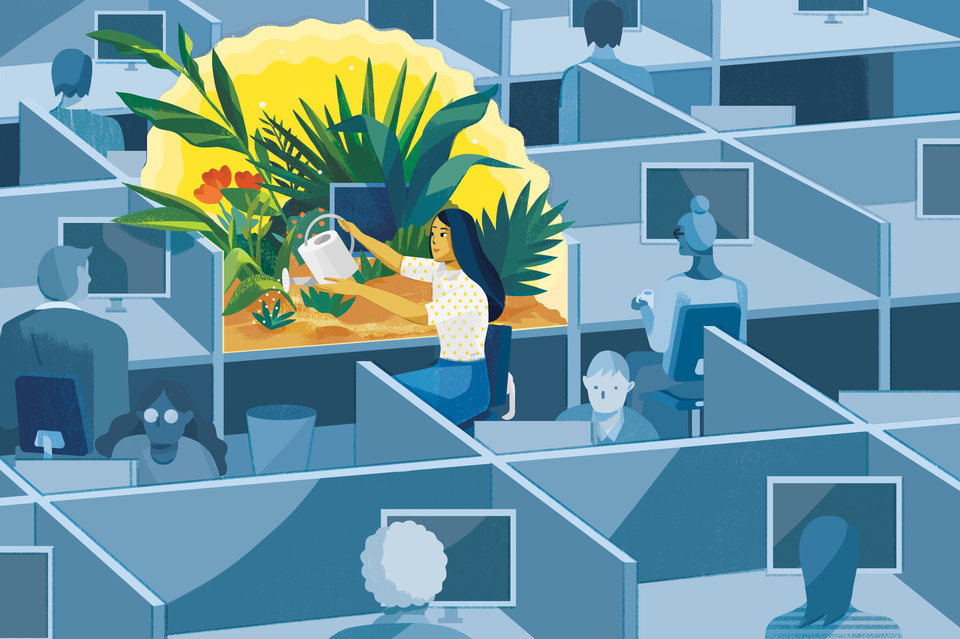No particular location required.
On any given workday, most people appreciate a little break time. But not everyone knows how valuable truly taking a moment can be ― because how you use a break is just as important as the break itself. It’s all too common: you finally get a much-needed break, and end up spending it playing a game on your phone, browsing the web, or using other methods of distraction to take you away from the here and now. Before you know it, the break is over, and it’s back to work feeling anything but refreshed.
What if there was a way for you to really take advantage of your work breaks, to improve your productivity and just your general sense of well-being? Together with Aetna, we want to show you how mindfulness ― the act of being present in the moment ― can help you achieve just that.
What Is Mindfulness?
Mindfulness is not a new concept ― its roots can be traced back to Buddhist practices in meditation. But this practice is having a moment in the mainstream during a time when most people are rarely away from a screen or disconnected from a constant barrage of communication ― which is no coincidence.
Michael Chaskalson, one of the U.K.’s leading mindfulness trainers, has worked with companies and individuals alike to educate them on incorporating mindfulness into busy lives. And he thinks that mindfulness is becoming more popular for a couple of reasons.
“It’s the coming together of two things,” said Chaskalson. “One is the science ― there’s been an extraordinary upsurge in research on mindfulness ― so we know a lot more.” The field is now far more grounded in facts, he added. “The other part is that people are struggling. It’s tough out there, we’re living in an ‘always on’ world. People aren’t taking breaks ― and some of these demands are self-imposed. It’s really important to come away from devices and actually experience the rest of the world.”
When I returned to work after giving birth to my son, I started meditating at the office for just five minutes daily. These short sessions really help me to transition from my ‘mom mind’ to my ‘boss mind.’ Janna Meyrowitz Turner, a mindfulness practitioner and founder of Style House Public Relations
Workers In The U.S. Are Taking Fewer Breaks
If you work for a living, chances are you’ve been touched by the “go, go, go” mentality that too often comes hand-in-hand with unprecedented constant availability, thanks to our now-ubiquitous digital connections. We’re getting more done than ever before, but at what cost?
Counterintuitive as it may seem, a growing body of research suggests that setting aside work to take breaks actually increases our productivity. However, when we do take breaks, the majority of us are taking low-quality breaks without paying attention to what will truly help us focus when we return to work. And the longer we work without interruption, the more our productivity suffers.
Small breaks from work are the perfect time to practice mindfulness ― by truly being present in the moment, paying attention to yourself and your surroundings.
“It’s very important to spend some time simply with your experience rather than with your thinking mind,” said Chaskalson. “Experiencing means, when you go for a walk, do you experience your body moving, do you experience sights, do you experience smells? Are you involved in the world around you?”
Every hour, I take a moment to stretch and consciously focus on how my body feels; this is the ultimate 30-second undercover mindfulness exercise. Selinde Berger, a mindfulness practitioner and founder of Zillionist, a business and lifestyle brand
 Rebekka Dunlap / Huffington Post Creative Labs
Rebekka Dunlap / Huffington Post Creative Labs Eat With Purpose
A genuine away-from-your desk “lunch hour” seems to be, for many, a relic of the past ― a time when workers weren’t expected to perform job duties in a moment’s notice and be reachable at any time. One survey from 2012 found that only one in five office workers even eat lunch away from their desks. The trouble is, eating is not something that should be done mindlessly. Mindless eating does not just limit your enjoyment of food ― it also tends to makes one eat faster, resulting in a delayed feeling of fullness and a higher calorie intake overall.
Susan Albers, a clinical psychologist and the bestselling author of Eating Mindfully, acknowledges that while a full lunch hour is ideal, it may not be realistic for many American workers. Leaving one’s office, let alone turning off devices and being unreachable, may seem like an impossibility (and, let’s be honest, zero distraction sounds like a recipe for boredom).
“Some of [what constitutes] mindful eating is really just a shift in mindset,” said Albers. “You can still have distractions, but the question is ‘Are you focused enough on what it is that you’re eating?’”
This focus can take many forms, but the most important part of it is presence of mind, and awareness of what you’re eating, how it tastes, and how you feel while eating it. No time to do this for your whole meal? Try just the first bite:
“Take a moment to take a deep breath or pause before you start eating, or make just your first bite be a mindful bite; because you become habituated to your food after a few bites, the first bite is actually the most flavorful,” she said.
Mindfulness has stopped many workplace snafus from happening in the first place. Once the mind is calm, a resolution can be reached. Diane Dye Hansen, a mindfulness practitioner and chief inspiration officer at What Works Coaching
Nurture Your Body And Mind
Are you a lunchtime gymgoer? While most of us wish to zone out during our workouts, you can use at least a portion of that time to practice mindfulness. Studies have found that being more mindful during exercise may actually affect our likelihood of sticking with a regular routine. The uptick in adherence researchers observe may have to do with the satisfaction we experience as a result of our awareness: awareness that reminds us why we’re taking care of our bodies, and how it makes us feel.
“If you’re exercising, don’t try to multitask,” said Chaskalson. “Don’t try to sit in the gym reading your emails or go for a run listening to an audiobook. When you’re running, run. When you’re on a treadmill, experience yourself running on a treadmill ― at least for some of the time.”
If meditation is more your speed, you can look forward to exercise of a different kind ― by improving the way your brain functions.
Judson Brewer, director of research at the Center for Mindfulness and an associate professor in the departments of medicine and psychiatry at the University of Massachusetts, is an expert in mindfulness training for addictions, and has studied how mindfulness and meditation affects the brain.
“When we look at brains of both novice and experienced meditators, their entire brain during meditation is less active than during baseline,” said Brewer. “There’s a certain part of the brain that gets activated when we get caught up in our experience ― [for example] when we’re stressed out, angry, ruminating or craving. This region is also the one that is deactivated during meditation and mindfulness. And when you’re deactivating that, it seems that the brain in general works more efficiently.”
To explain this concept, he uses an analogy: “[Imagine] we’re driving the car with one foot on the brake and one on the gas. When we pull our foot off the brake, we don’t have to apply any more gas ― the car drives faster and more efficiently. In the same way, if we get out of our own way, then our brains are freed up to function more efficiently and do their jobs better.”
Even if you don’t have the flexibility to take long breaks, you can still incorporate this important practice into your daily life ― and add some much-needed relief and replenishment to your regular routine.
From: The Huffington Post

